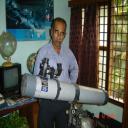Yahoo Answers is shutting down on May 4th, 2021 (Eastern Time) and beginning April 20th, 2021 (Eastern Time) the Yahoo Answers website will be in read-only mode. There will be no changes to other Yahoo properties or services, or your Yahoo account. You can find more information about the Yahoo Answers shutdown and how to download your data on this help page.
Trending News
Cepheid Variable Stars?
Can someone please break down for me why we can learn the distance of galaxies via observing these stars. I know that they pulsate, and supposedly, the relationship between their pulsations and time we are able to estimate the distance. I guess I just don't understand that concept.
But how. That's what I'm asking. Is it because of how long it takes for the light to reach us when it pulsates? or what?
Is it because we can compare it to itself? Its apparent mag at one time with its apparent mag at another?
3 Answers
- Larry454Lv 71 decade agoFavorite Answer
The period of variability, which we can measure, is directly related to the absolute luminosity of the star. We can also measure the apparent luminosity of the star. The apparent luminosity is related to the absolute luminosity of the star by it's distance (raised to the 4th power, as I recall). Therefore, since you know the period, you also know the absolute luminosity. Since you can measure the apparent luminosity, you can use the absolute and apparent luminosities to solve for the distance. There is some error band involved, so most of these calculations are done with several Cepheid variables found in a single large structure, like a galaxy - so that you can get a statistically meaningful sample.
ADDED: Yes that's about right. Apparent mag doesn't help all by itself. If it did, we would know the distance to all the stars simply by measuring their magnitude. But if you know the absolute magnitude - the luminosity of the star when you are right next to it - undimmed by distance - and you also know the apparent mag as measured in your scope - then you can determine its approximate distance by the inverse square law.
The interesting thing about Cepheid Variables is that their period of fluctuation varies in a predictable fashion with their absolute magnitude, or luminosity. Once we measure the period, we can deduce the absolute luminosity. Once we know the absolute luminosity, we can measure the apparent luminosity, thereby giving us the tools needed to determine the distance. I do not know the relation between the absolute luminosity and the period, so I don't know whether it is based on the average or the peak, or both. But that's the approach.
- Chandramohan P.RLv 71 decade ago
The period luminosity relation can be used to estimate distance as the period measurement with standard candle gives idistances
- Mark GLv 71 decade ago
The period of a Cepheid is related to it's luminosity. If you know that you know it's distance.






